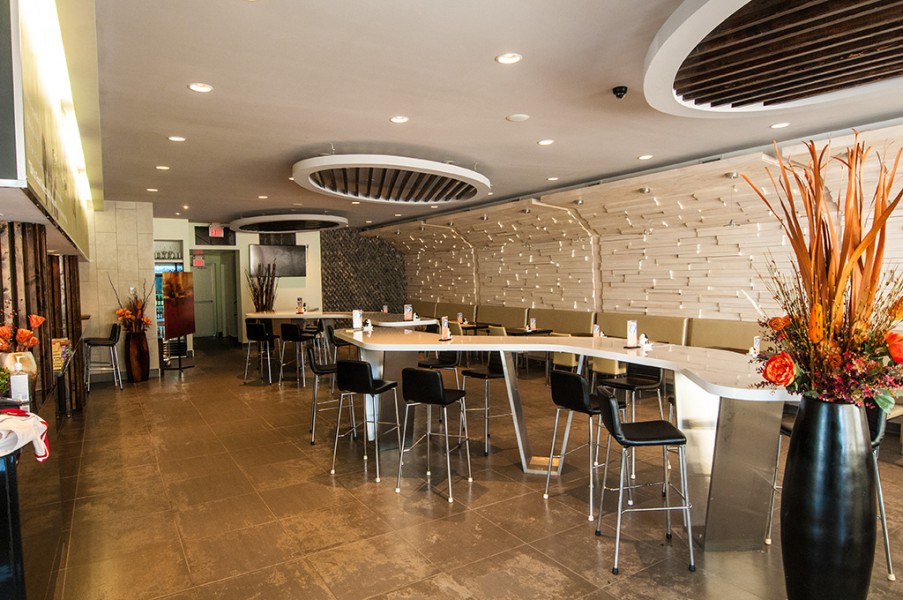Regina’s newest Korean restaurant is gorgeous
by Aidan Morgan
Life Is Good Korean BBQ Restaurant
438 Victoria Avenue
306-585-6732
![]()
I’m no expert on Korean food. Sure, I know my gochujang (spicy paste) from my jjajang (not spicy paste), and I suppose I could tell you a thing or two about items like galbi (short ribs) and yam noodles (noodles… made from yams… I think). But my experience is largely limited to a few restaurants and occasional blind shopping expeditions at Korean supermarkets.
(Which, by the way, is a great way to discover new food. Pick something you don’t recognize, pretend it’s your favourite when the cashier asks if you know what you’re buying, and Google the hell out of it when you get home. Ignore the possibility that the food item you bought may still be alive, or possibly something unearthed from an ancient tomb.)
Is there some award for local restaurant design? Because LIG Korean BBQ wins. The owners have created a gorgeous, airy space full of textured surfaces and simple shapes. The back wall, with its graceful curvature and layered wooden planks, is striking. It’s one of the few restaurants in the city that manages not to look like an indifferently redressed office.
Ergonomics are another matter. Much of the food is meant to be cooked, or at least finished, at the table — which means that tables are equipped with induction surfaces. In theory it’s great, but things can get crowded extremely quickly, with platters and glasses and bottles bumping up against stone grills and metal pans. It can be a bit awkward, especially when the servers are leaning in to cook your food.
For lunch time, I took two newly anointed Knights of Appetite. They swiftly became drunk with power but that’s a whole other story. One tried the Japchae bap ($13.99), rice over yam noodles with beef, and the other went for the box lunch ($15.99) — a sort of deconstructed Korean bento, with spicy rice, grilled beef, little seasoned vegetables (that’s the technical term, I assure you) and a serving of crunchy kimchi. Everything tasted extremely Korean, which is to say, it tasted really good. I’ve never been a huge fan of yam noodles and their strangely springy texture, but it was an interesting dish to try out.
I went straight for the dolsot bibimbap ($15.99), because that dish is straight-up proof that god exists and loves us (maybe not some omnipotent father-creator existing in eternity, but at least some minor deity concerned with flavours and good spices). Dolsot bibimbap is rice and meat (I went for seafood) and various vegetables with a dollop of spicy gochujang and a lightly fried egg on top served in a sizzling hot stone bowl. You break the yolk open and mix it in with the vegetables and rice, and it continues to cook as you eat it. You can wait for the egg to cook thoroughly before you start in or you can shrug your shoulders and race those swiftly denaturing proteins to the bottom of the bowl. At the end you’ll be left with a few sheets of cooked egg and rice, which are nice and crunchy.
(A warning about dolsot bibimbap: do not touch the bowl. Do not lean forward until your jacket/tie/scarf touches the bowl. Do not put your tongue on the bowl or put it on your head in a spirit of play, because you’ll have to remove it immediately in a spirit of being really badly burnt.)
Supper was a very different experience. The menu is divided into a series of “single” dishes ($19.99 each), meals for two ($38.99) such as Shabu-shabu, a korean fondue, and main dishes for $28.99. The main dishes come as part of a multi-course meal: a steamed egg starter, appetizer, house salad, side dish and dessert.
The ludicrously good egg was a really nice way to whet the appetite. After the egg, the soup, salad and sides were served on a platter that included long pieces of romaine. For the appetizer I chose the egg roll, a term that Koreans apparently take literally; this egg roll was a tiny omelette with little slivers of vegetable. Other Knights at the table tried the tofu, a grilled, salty and spicy patty. The skewer was an adorably tiny corn dog. I didn’t get a chance to try it, because someone named John Cameron shoved it in his greedy mouth right away.
The noodles were cool, slim and slurpworthy. I threw in a pile of bean paste, peppers, garlic and onions that accompanied the platter. The soup was a dashi-style broth that tasted a little more strongly of the sea than I like, so I left it alone after a few sips.
Somewhere in the midst of all this food, the servers rolled out the main dishes. We had ordered the Ori-jumeulluck (duck marinated in soy sauce, sesame oil and minced garlic), the smoked Samgupsal (slices of side pork, which looked much like thick bacon), the excellently named Gangodeungeougul (grilled salted mackerel) and the spicy galbi (ribs, ribs and ribs). In each case, the server continued to cook our meals at the table. We were cheerfully instructed to spoon the food and condiments onto the romaine leaves and eat up. We cheerfully obliged.
The results ranged from excellent to decent. By far my favourite was the galbi, which is a pretty reliable bet at a Korean restaurant. The meat was tender enough to remove from the bone and had a rich, sweet tang that reminded me of traditional North American barbecue.
I wasn’t as crazy about the other dishes. Mackerel is simply not my favourite fish, so no amount of bean paste and stone grilling is going to mask the taste. The duck didn’t have much flavour and its texture was pronounced as ‘rubbery’ by one KoA. This wasn’t meant as a complaint but in my book, duck should be tender. Come by and see my book some time. It’s full of tender ducks.
The smoked pork was good but it was much less substantial than the other main dishes. I can picture an unsuspecting diner feeling a little blindsided at getting a few strips of fatty meat for a main course. Fairly or not, diners in Regina probably expect sizable portions for a $30 meal.
Dessert was something called soojungkwa, a traditional Korean cinnamon drink made with ginger and persimmon and garnished with pine nuts. LIG offers the drink hot or chilled. A couple of us poured a little bit of soju ($15/bottle) into the drink, which is probably a violation of good taste but the addition proved surprisingly tasty. (For the benefit of soju enthusiasts, LIG stocks the mild-tasting brand Chum-Churum.)
A note on heat: the kitchen at LIG has clearly decided to temper the spiciness of much Korean food. Unless you’re very sensitive, you’ll probably be okay with the level of heat in even the spicier dishes. Gochujang’s burn tends to ramp up over the course of a meal, though, so take care.
I’d heard that LIG might be packed but on both visits the restaurant was nearly empty and it didn’t look as if the other patrons were splurging on set dinners (one table seemed to subsist on cups of tea and nothing else). Good restaurants deserve to thrive, so do yourself a favour and check the place out.
WHAT IS IT? Life Is Good Korean BBQ Restaurant.
WHAT’S IT FOR? Lunch and supper; and, as Knight of Appetite John put it, “It’s where you go when you want to impress the shit out of your date.” That’s not how I want to impress a date, but different strokes and all that.
WHEN’S IT OPEN? Tuesday & Wednesday, 11:30 a.m.-8:30 p.m.; Thursday-Saturday, 11:00 a.m.-9:30 p.m.; Sunday, 5:00-8:30 p.m.
WHAT’S IT COST? Lunch is $13-20; supper, $25-$40.
BEWARE OF: The cords under the table that power the induction cooking surfaces.






